Sonic Youth | ||
| Allmusic Biography : Sonic Youth were one of the most unlikely success stories of underground American rock in the 80s. Where contemporaries R.E.M. and Hüsker Dü were fairly conventional in terms of song structure and melody, Sonic Youth began their career by abandoning any pretense of traditional rock & roll conventions. Borrowing heavily from the free-form noise experimentalism of the Velvet Underground and the Stooges, and melding it with a performance art aesthetic borrowed from the New York post-punk avant-garde, Sonic Youth redefined what noise meant within rock & roll. Sonic Youth rarely rocked, though they were inspired directly by hardcore punk, post-punk, and no wave. Instead, their dissonance, feedback, and alternate tunings created a new sonic landscape, one that redefined what rock guitar could do. The bands trio of independent late-80s records -- EVOL, Sister, Daydream Nation -- became touchstones for a generation of indie rockers who either replicated the noise or reinterpreted it in a more palatable setting. As their career progressed, Sonic Youth grew more palatable as well, as their more free-form songs began to feel like compositions and their shorter works began to rock harder. During the 90s, most American indie bands, and many British underground bands, displayed a heavy debt to Sonic Youth, and the group itself had become a popular cult band, with each of its albums charting in the Top 100. Such success was unthinkable when guitarists Thurston Moore and Lee Ranaldo formed Sonic Youth with bassist Kim Gordon in 1981. Moore had spent his childhood in Bethel, Connecticut; Ranaldo was from Long Island. Both guitarists arrived in Manhattan during the height of the New York-based post-punk no wave movement, and began performing with the avant-garde composer Glenn Branca, whose dissonant, guitar-based music provided the basis for much of Sonic Youths early music. Moores girlfriend Gordon had been active in the avant and no wave scenes for some time, and the pair helped stage the Noise Festival, in which the band made its live debut during the summer of 1981. At the time, Sonic Youth also featured keyboardist Anne DeMarinis and drummer Richard Edson. DeMarinis left the band shortly afterward, and the quartet recorded its eponymous debut EP, which was released on Brancas Neutral Records the following year. During 1983, Edson left the band to pursue an acting career and he was replaced by Bob Bert, who drummed on the groups debut album, Confusion Is Sex (1983). The band supported the album with its first European tour. Later that year, the group released the EP Kill Yr Idols on the German Zensor label. Early in 1984, Moore attempted to land the band a contract with the British indie label Doublevision, but the label rejected the demos. Paul Smith, one of the owners of Doublevision, decided to form Blast First Records in order to release Sonic Youth records. Soon, he received a distribution deal from the hip U.K. indie label Rough Trade, and the band had its first label with strong distribution. During all these record label negotiations in 1984, the cassette-only live album Sonic Death: Sonic Youth Live was released on Ecstatic Peace. Bad Moon Rising, the groups first album for Blast First, was released in 1985 to strong reviews throughout the underground music press. The album was markedly different from their earlier releases -- it was the first record they made that incorporated their dissonant, feedback-drenched experimentations within relatively straightforward pop song structures. Following the release of the Death Valley 69 EP, Bert was replaced by Steve Shelley, who became the groups permanent drummer. Bad Moon Rising had attracted significant attention throughout the American underground, including some offers from major labels. Instead, Sonic Youth decided to sign with SST, home of Hüsker Dü and Black Flag, releasing EVOL in 1986. With EVOL, the group a became fixture on college radio, and its status grew significantly with 1987s Sister, which was heavily praised by mainstream publications like Rolling Stone. The groups profile increased further with the 1988 Ciccone Youth side project The Whitey Album, which was a tongue-in-cheek tribute to Madonna and other parts of mainstream pop culture. The bands true breakthrough came later in 1988 with the double album Daydream Nation. Released on Enigma Records, it was a tour de force that was hailed as a masterpiece upon its fall release, and it generated a college radio hit with "Teenage Riot." Though the album was widely praised, Enigma suffered from poor distribution and eventually bankruptcy, which meant the album occasionally wasnt available in stores. These factors contributed heavily to the bands decision to move to the major label DGC in 1990. Signing a contract that gave them complete creative control, as well as letting them function as pseudo-A&R; reps for the label, Sonic Youth established a precedent for alternative bands moving to majors during the 90s, proving that it was possible to preserve indie credibility on a major label. Released in the fall of 1990, Goo, the bands first major-label album, boasted a more focused sound, yet it didnt abandon the groups noise aesthetics. The result was a college radio hit, and the groups first album to crack the Top 100. Neil Young invited Sonic Youth to open for him on his arena tour for Ragged Glory, and though they failed to win over much of the rockers audience, it represented their first major incursion into the mainstream; it also helped make Young a cult figure within the alternative circles during the 90s. For their second major-label album, Dirty, Sonic Youth attempted to replicate the sloppy, straightforward sound of grunge rockers Mudhoney and Nirvana. The band had been supporting those two Seattle-based groups for several years (and had released a split single with Mudhoney and brought Nirvana to DGC Records), and while the songs on Dirty were hardly grunge, it was more pop-oriented and accessible than earlier Sonic Youth records. Produced by Butch Vig, who also produced Nirvanas Nevermind, Dirty became an alternative hit upon its summer 1992 release, generating the modern rock hits "100%," "Youth Against Fascism," and "Sugar Kane." Sonic Youth quickly became hailed as one of the godfathers of the alternative rock that had become the most popular form of rock music in the U.S., and Dirty became a hit along with the exposure, eventually going gold. Sonic Youth again worked with Vig for 1994s Experimental Jet Set, Trash and No Star, which entered the U.S. charts at number 34 and the U.K. charts at number ten, making it their highest-charting album ever. The high chart position was proof of their popularity during the previous two years, as it received decidedly mixed reviews and quickly fell down the charts. Later in 1994, Moore and Gordon -- who had married several years before -- had their first child, a daughter named Coco Haley. Sonic Youth agreed to headline 1995s American Lollapalooza package tour, using the earnings to build a new studio. Following the completion of the tour, Sonic Youth released Washing Machine, which received their strongest reviews since Daydream Nation. After a series of experimental EPs issued on their own SYR label, they resurfaced in 1998 with the full-length A Thousand Leaves. NYC Ghosts & Flowers, which featured Jim ORourke as a producer and musician, followed in the spring of 2000. ORourke became a full member of the group, touring with the band and appearing on and producing 2002s Murray Street. The five-piece Sonic Youth returned in 2004 with Sonic Nurse; one year later, however, ORourke departed the band to pursue a career as a film director. Late in 2005, the remaining bandmates issued SYR 6, a recording of a benefit concert for the Anthology Film Archives that Sonic Youth had played alongside percussionist Tim Barnes. Rather Ripped, a fusion of the mellow, sprawling feel of the bands previous two albums with a more stripped-down sound, was released in 2006. In 2008, the band resurrected the SYR series: JAccuse Ted Hughes arrived that spring as a vinyl-only release, while Andre Sider Af Sonic Youth chronicled an improvised performance at 2005s Roskilde Festival. They also assembled a compilation album for Starbucks, Hits Are for Squares, featuring the previously unreleased track "Slow Revolution." Before the busy year concluded, Sonic Youth made additional headlines by leaving the Geffen label and signing with Matador, which prepared to issue the bands 16th album, The Eternal, during the following spring. The year 2010 was relatively quiet for the band, with members concentrating on individual projects like Shelleys Vampire Blues label; they also recorded the soundtrack to French director Fabrice Goberts film Simon Werner a Disparu, which was released early in 2011. Moore and Gordon announced their impending divorce in the fall of 2011, creating doubt about the bands future past their year-end South American tour. Sonic Youths São Paulo date that November ended up being their final concert before an indefinite hiatus. The bands members remained busy: among their other projects, Gordon worked with experimental guitarist Bill Nace as Body/Head, and with Tomorrows Tulips Alex Knost as Glitterbust; she also published her memoir, Girl in a Band. Moore toured and recorded with new act Chelsea Light Moving and continued his solo career. Ranaldo recorded as a solo artist and with a new band, the Dust, which featured Shelley as well as ORourke and guitarist Alan Licht. In addition, Shelley played with Hallogallo 2010, Disappears, and Sun Kil Moon. He also ran Sonic Youths labels SYR and Goofin, the latter of which released the live album Smart Bar: Chicago 1985 and Spinhead Sessions, a set of 1986 rehearsals for the bands Made in USA soundtrack. | ||
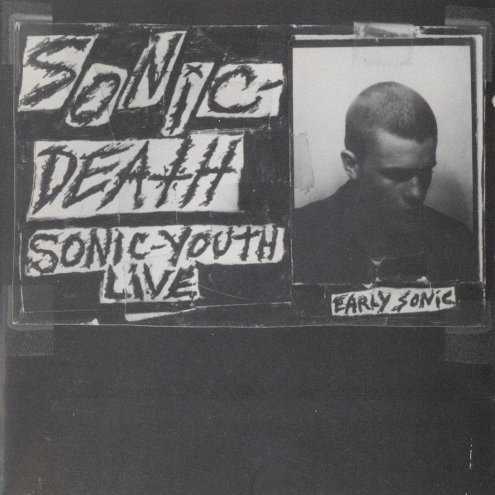 | Album: 1 of 28 Title: Sonic Death: Sonic Youth Live Released: 1983 Tracks: 1 Duration: 1:08:02 Scroll: Up Down Top Bottom 25% 50% 75% Wikipedia AlbumCover | 1 Early Sonic - 1981-83 (1:08:02) |
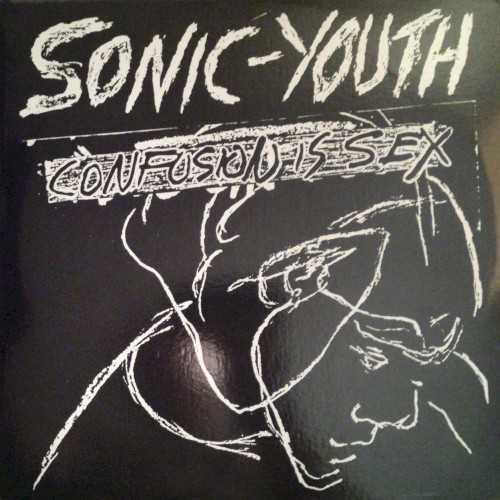 | Album: 2 of 28 Title: Confusion Is Sex Released: 1983 Tracks: 13 Duration: 51:16 Scroll: Up Down Top Bottom 25% 50% 75% Spotify TrackSamples Wikipedia Allmusic AlbumCover | 1 (Shes in a) Bad Mood (05:36) 2 Protect Me You (05:28) 3 Freezer Burn / I Wanna Be Your Dog (03:39) 4 Shaking Hell (04:06) 5 Inhuman (04:02) 6 The World Looks Red (02:43) 7 Confusion Is Next (03:28) 8 Making the Nature Scene (03:01) 9 Lee Is Free (03:37) 10 Kill Yr. Idols (02:51) 11 Brother James (03:17) 12 Early American (06:07) 13 Shaking Hell (03:15) |
| Confusion Is Sex : Allmusic album Review : Abrasive and archaic, theatrical and confrontational, Confusion Is Sex marks the opening strides that Sonic Youth made during their long slog through the American underground scene of the 80s. And yes, this album is underground if anything -- its lo-fi to the point of tonal drabness, as the instruments seem to ring out in only one tone, that of screechy noise. Yet that tone in itself is part of the albums style, which is one of antithesis. The album isnt comprised of songs but rather soundscapes, while the instruments are your traditional guitar-bass-drums-vocals lineup but are performed most untraditionally. Taken as a whole, Confusion Is Sex is a spellbinding listen, especially the first time through. If youre a bona fide Sonic Youth fan, chances are youll find it especially spellbinding -- the more of the bands albums youve heard, the better. However, if youre unfamiliar with the band, or a casual fan at most, chances are youre going to be thoroughly tested -- this is not an easy album to enjoy. As inaccessible as it may be, however, Confusion Is Sex is a cornerstone of Sonic Youths career, their true opening salvo toward underground heroism, though miles and miles away from such highly regarded albums as Daydream Nation (1988) or Dirty (1992). | ||
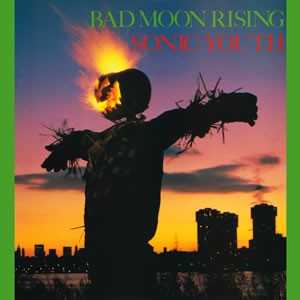 | Album: 3 of 28 Title: Bad Moon Rising Released: 1985 Tracks: 8 Duration: 37:27 Scroll: Up Down Top Bottom 25% 50% 75% Spotify TrackSamples Wikipedia Allmusic AlbumCover | 1 Intro (01:10) 2 Brave Men Run (In My Family) (03:37) 3 Society Is a Hole (05:54) 4 I Love Her All the Time (07:28) 5 Ghost Bitch (05:40) 6 I’m Insane (04:07) 7 Justice Is Might (04:21) 8 Death Valley ’69 (05:10) |
| Bad Moon Rising : Allmusic album Review : An album quite unlike any other in the colorful Sonic Youth canon, Bad Moon Rising captures the New York band in 1985 during its most morose phase, one that is quite forbidding yet fascinating all the same. The proper album is an eight-song tapestry of droning guitar feedback, distant clattering percussion, and dreamy vocal mumblings, all of it woven together by sullen interludes of ambient noise. With the exception of the closing "Death Valley 69," nothing really stands out per se. Each song shares the same late-night shadowy feel as the others, with no outright singalong hooks to be found anywhere; its just one ambling slab of dark noise rock. "Death Valley 69" then brings it all to a feverish close, driven by runaway guitar riffs and a frantic vocal duet by Thurston Moore and Lydia Lunch. Its a piercing capstone to an otherwise hazy album and is no doubt one of the highlights of Sonic Youths overall output. Most editions of Bad Moon Rising dont end there, however. DGCs CD-era re-release appends the Flower EP, which fits in rather well. Similarly morose, these few songs are perhaps even more out-there than the Bad Moon Rising ones, especially "Halloween," which is a subtle five minutes of creeping guitar tingles accented beautifully by Kim Gordons whispery hallucinations. Overall, this music is a definite leap forward from what Sonic Youth had been doing previously on Confusion Is Sex (1983) and Kill Yr. Idols (1983); it plays as one long piece, a work that perhaps reflects the spirit of the time, American gothic through the glassy eyes of willful moonlit paranoia. And as such, its certainly a step toward EVOL (1986), the bands successive release, which is likewise obsessed with the dark side of America and likewise informed by sweeping waves of ambient guitar noise, but much more song-based and focused than Bad Moon Risings dreamscape feel. | ||
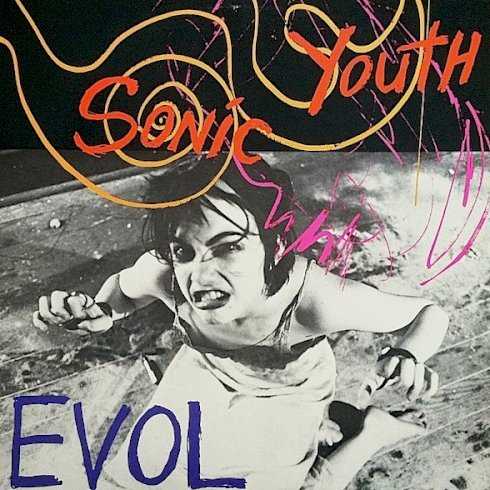 | Album: 4 of 28 Title: EVOL Released: 1986-05 Tracks: 9 Duration: 36:15 Scroll: Up Down Top Bottom 25% 50% 75% Spotify TrackSamples Wikipedia Allmusic AlbumCover | 1 Tom Violence (03:05) 2 Shadow of a Doubt (03:33) 3 Star Power (04:49) 4 In the Kingdom #19 (03:25) 5 Green Light (03:46) 6 Death to Our Friends (03:19) 7 Secret Girl (02:54) 8 Marilyn Moore (04:04) 9 Expressway to Yr. Skull (07:19) |
| EVOL : Allmusic album Review : By 1986, a still relatively recently formed Sonic Youth was in a time of transition. Born out of the noise of New Yorks thriving-in-ugliness no wave scene and ensconced in the influence of Glenn Brancas avant-garde guitar experimentalism, the bands early albums slowly morphed from the snotty abrasive clatter of its self-titled EP and spotty first proper LP Confusion Is Sex into a far darker but still somewhat inconsistent merging of haunted song sketches and foreboding noisy atmospheres on second album Bad Moon Rising. EVOL found the band in a similarly eerie mindset, but this time the dark dreaminess of songs like "Tom Violence," the tense instrumental "Death to Our Friends," and the gorgeously restrained "Shadow of a Doubt" are snapped into lockstep clarity by Steve Shelleys precise, tom-heavy drumming. Shelley, still a fresh-faced Michigan transplant to N.Y.C., joined the band on EVOL, replacing ex-Pussy Galore drummer Bob Bert, whose trash can percussion added some of the roughness to earlier Sonic Youth albums. While EVOL is still an album steeped in the noise and collage aesthetic the band grew from (most notable in the tape experiments, unexpected screams, and mesh of feedback and car-race sound effects of Lee Ranaldos spoken word contribution "In the Kingdom #19" and the ghostly music-box loop and Kim Gordons slithering vocals on "Secret Girls"), the songs here also represent the bands first flirtations with pop. Though gift-wrapped in jagged guitar tones and airy alternate tunings, songs like "Green Light," "Star Power," and the hypnotic bliss-out of album closer "Expressway to Yr. Skull" are built on cores of reaching melodicism and a tunefulness that borders at times on sounding playful. The addition of Shelleys propulsive drumming gave much-needed punctuation to the bands previously murky approach and connected some of the amorphous Halloween-themed textures the band was immersed in at the time to more deliberate, even traditional song structures. This affection for big, dumb, simplistic pop is driven home by their cover of Kim Fowleys unabashedly sleazy rocker "Bubblegum," included as a bonus track on early non-LP versions of the album. A product of a band finding its way between worlds, EVOL is a remarkably strong effort, and sets the stage for crystallizing ideas that would soon result in what many considered the bands finest work. | ||
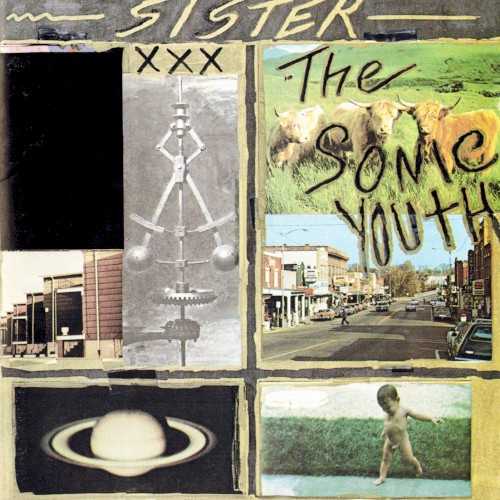 | Album: 5 of 28 Title: Sister Released: 1987-06 Tracks: 11 Duration: 43:02 Scroll: Up Down Top Bottom 25% 50% 75% Spotify TrackSamples Wikipedia Allmusic AlbumCover | 1 Schizophrenia (04:38) 2 (I Got a) Catholic Block (03:26) 3 Beauty Lies in the Eye (02:19) 4 Stereo Sanctity (03:50) 5 Pipeline / Kill Time (04:35) 6 Tuff Gnarl (03:14) 7 Pacific Coast Highway (04:17) 8 Hot Wire My Heart (03:23) 9 Kotton Krown (05:08) 10 White Kross (02:58) 11 Master-Dik (05:10) |
| Sister : Allmusic album Review : The blunt, chaotic sound of Sonic Youths visionary but difficult early work had begun to give way to a more coherent and song-oriented attack on 1986s EVOL, and with 1987s Sister, Sonic Youth revealed that they were a great rock band as well as a great art band. From the shifting dynamics and disquieting mood of the opening track "Schizophrenia" to the ferocious coda of "White Cross," Sister was the work of a band that had grown impressively stronger and more unified in the 12 months since their previous long-player. The sheets of sound that issued from Thurston Moore and Lee Renaldos re-tuned and modified guitars were still the core of their sound, but Sonic Youths songcraft was steadily improving as they made better and more effective use of their aural palette and created a melodic context that helped their noisy report make greater dramatic sense. After going through a handful of drummers, Steve Shelley finally gave Sonic Youth the combination of chops, imagination, and force that they needed behind the kit, and while he certainly improved EVOL (his debut with the group), it was Sister where he truly make his mark: the steady pulse and rhythmic shadings of "Catholic Block," "Stereo Sanctity," and "Tuff Gnarl" helped firm up the tunes and added some discipline to Moore and Renaldos exploratory guitar work that, remarkably, made their twisted instrumental figures more impressive and no less distinctive. And the warmth and clarity of Bill Titus all-analog engineering made the guitars (and Kim Gordons bass) sound as glorious as they always deserved; while Sonic Youth had been a band with great ideas from the start, Sister was where the execution finally caught up with the concept, and it was their first truly great album. | ||
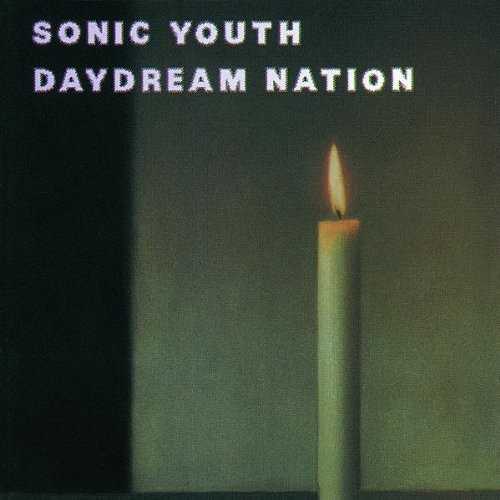 | Album: 6 of 28 Title: Daydream Nation Released: 1988-10 Tracks: 12 Duration: 1:10:45 Scroll: Up Down Top Bottom 25% 50% 75% Spotify Allmusic AlbumCover | 1 Teen Age Riot (06:57) 2 Silver Rocket (03:47) 3 The Sprawl (07:41) 4 ’Cross the Breeze (07:00) 5 Eric’s Trip (03:48) 6 Total Trash (07:33) 7 Hey Joni (04:23) 8 Providence (02:41) 9 Candle (04:59) 10 Rain King (04:39) 11 Kissability (03:08) 12 Trilogy: The Wonder / Hyperstation / Eliminator Jr. (14:03) |
| Daydream Nation : Allmusic album Review : Sonic Youth made a major step forward with 1987s Sister, their first album where the songs were as strong as the groups visionary approach and they rocked with the force and authority theyd clearly sought since the beginning. If 1988s Daydream Nation didnt make as decisive a leap in terms of theory or style, as far as execution was concerned, it was Sonic Youths first unqualified masterpiece, a triumph that made them one of the most respected bands in indie rock. Initially released as a two-LP set, the sheer scope of Daydream Nation was ambitious, but the longer tracks worked to Sonic Youths advantage, allowing them the space to lay down solid melodic structures and then use them as a framework for extended jams (thankfully, the band made splendid use of their wanderlust without wearing out their welcome). Sonic Youth were playing at the top of their game on the Daydream Nation sessions; the guitar interplay between Thurston Moore and Lee Ranaldo was stronger and more intuitive than before, and bassist Kim Gordon and drummer Steve Shelley had grown into a powerful rhythm section that cut an impressive groove, giving the band a greater freedom to explore the space around them without getting lost. Sonic Youth were not simply tighter on Daydream Nation, they were making better and more satisfying use of their arsenal of alternate tunings and bent but elemental song structures, and the final product fused their love of creatively applied noise and the sound of the electric guitar with song structures that merged elements of punk, prog, boogie, and psychedelia. The journey from the trippy joy of "Teenage Riot" to the hot-rodded choogle of "Eliminator Jr." was a bracing, glorious experience, and Daydream Nation confirmed their status as one of Americas best and most original alternative rock bands, and one that had a shot at a future outside the underground -- a pleasant surprise given the alienating air of their earliest work. | ||
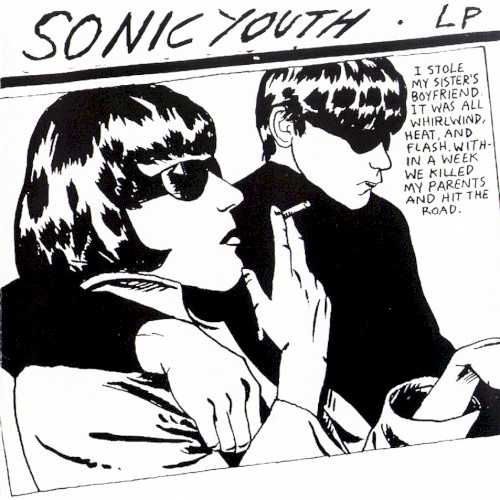 | Album: 7 of 28 Title: Goo Released: 1990-06-26 Tracks: 11 Duration: 49:54 Scroll: Up Down Top Bottom 25% 50% 75% Spotify TrackSamples Wikipedia Allmusic AlbumCover | 1 Dirty Boots (05:28) 2 Tunic (Song for Karen) (06:22) 3 Mary‐Christ (03:11) 4 Kool Thing (04:06) 5 Mote (07:37) 6 My Friend Goo (02:19) 7 Disappearer (05:08) 8 Mildred Pierce (02:13) 9 Cinderella’s Big Score (05:54) 10 Scooter + Jinx (01:06) 11 Titanium Exposé (06:24) |
| Goo : Allmusic album Review : Any doubts as to the continuing relevance of Sonic Youth upon their jump to major-label status were quickly laid to rest by Goo, their follow-up to the monumental Daydream Nation. While paling in the shadow of its predecessor, the record is nevertheless a defiant call to arms against mainstream musical values; the Geffen logo adorning the disc is a moot point -- Goo is, if anything, a portrait of Sonic Youth at their most self-indulgently noisy and contentious, covering topics ranging from Karen Carpenter ("Tunic") to UFOs ("Disappearer") to dating Jesus mom ("Mary-Christ"). Even Public Enemys Chuck D joins the fracas on the single "Kool Thing," which teeters on the brink of a cultural breakthrough but falls just shy of the mark; the same could be said of Goo itself -- by no means a sellout, it nevertheless lacks the coherence and force of the groups finest work, and the opportunity to violently rattle the mainstream cage slips by. | ||
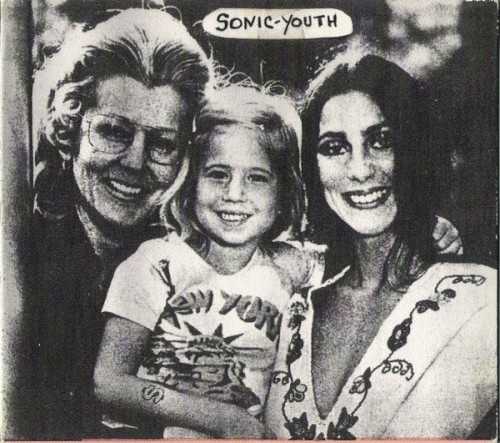 | Album: 8 of 28 Title: Goo Demos Released: 1991 Tracks: 12 Duration: 58:34 Scroll: Up Down Top Bottom 25% 50% 75% AlbumCover | 1 Tunic (06:43) 2 Number One (04:58) 3 Titanium Exposé (04:54) 4 Dirty Boots (05:51) 5 Corky (06:22) 6 My Friend Goo (02:37) 7 Bookstore (04:16) 8 Animals (03:10) 9 Du 2 (04:19) 10 Blow Job? (08:52) 11 Lee #2 (03:35) 12 Dirty Boots (single edit) (02:53) |
 | Album: 9 of 28 Title: Hold That Tiger Released: 1991 Tracks: 18 Duration: 58:35 Scroll: Up Down Top Bottom 25% 50% 75% Spotify Wikipedia Allmusic AlbumCover | 1 Intro (00:43) 2 Schizophrenia (04:30) 3 Tom Violence (02:43) 4 White Cross (02:57) 5 Kotton Krown (04:05) 6 Stereo Sanctity (03:27) 7 Brother James (03:22) 8 Pipeline / Kill Time (04:03) 9 Catholic Block (03:55) 10 Tuff Gnarl (03:26) 11 Death Valley 69 (04:50) 12 Beauty Lies in the Eye (02:40) 13 Expressway to Yr Skull (04:32) 14 Pacific Coast Highway (04:59) 15 Loudmouth (02:01) 16 I Don’t Wanna Walk Around With You (01:33) 17 Today Yr. Love, Tomorrow the World (02:00) 18 Beat on the Brat (02:40) |
| Hold That Tiger : Allmusic album Review : Hold That Tiger is an official bootleg documenting a Sonic Youth live show in Chicago on October 14, 1987. It has the same lo-fi sound as Televisions The Blow Up, but lacks the spirit of those performances. Sonic Youth is on safe ground here, not indulging themselves in the guitar freakouts that they frequently showcase during their live sets. Most of the set list from this show comes from Sister and EVOL, while the encore shows Sonic Youth appropriately mauling four songs from the Ramones first album. | ||
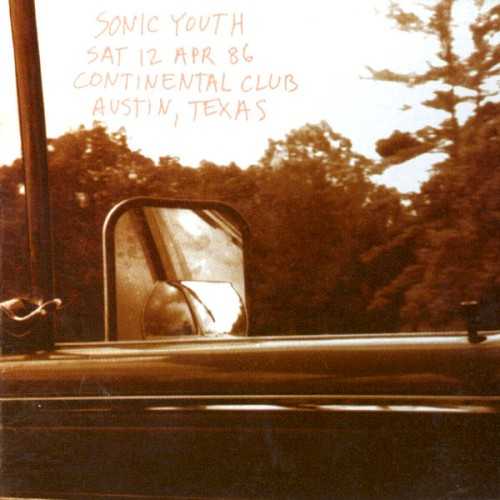 | Album: 10 of 28 Title: Live at the Continental Club Released: 1992 Tracks: 13 Duration: 59:52 Scroll: Up Down Top Bottom 25% 50% 75% Spotify AlbumCover | 1 Tom Violence (05:36) 2 Shadow of a Doubt (03:36) 3 Star Power (04:56) 4 Secret Girls (04:24) 5 Death to Our Friends (04:03) 6 Green Light (03:24) 7 Kill Yr Idols (03:11) 8 Ghost Bitch (06:04) 9 Expressway (08:08) 10 World Looks Red (02:47) 11 Confusion (Indeed) (02:19) 12 [crowd noise] (02:09) 13 [untitled] (09:10) |
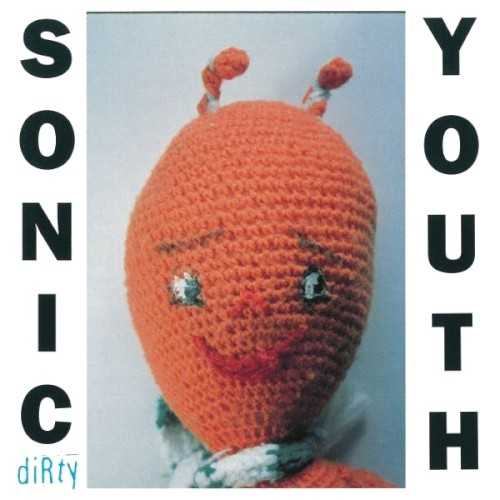 | Album: 11 of 28 Title: Dirty Released: 1992-07-20 Tracks: 15 Duration: 59:04 Scroll: Up Down Top Bottom 25% 50% 75% Spotify Wikipedia Allmusic AlbumCover | 1 100% (02:29) 2 Swimsuit Issue (02:59) 3 Theresa’s Sound‐World (05:28) 4 Drunken Butterfly (03:04) 5 Shoot (05:16) 6 Wish Fulfillment (03:26) 7 Sugar Kane (05:57) 8 Orange Rolls, Angel’s Spit (04:19) 9 Youth Against Fascism (03:36) 10 Nic Fit (00:59) 11 On the Strip (05:42) 12 Chapel Hill (04:47) 13 JC (04:03) 14 Purr (04:22) 15 Créme Brûlèe (02:33) |
| Dirty : Allmusic album Review : When DGC Records signed Nirvana in 1991, one of DGCs A&R reps expressed the opinion that, with plenty of touring and the right promotion, the new act might sell as well as its labelmate and touring partner Sonic Youth. The surprise success of Nevermind upended previous commercial expectations for Sonic Youth (among other established alternative rock bands), and when Dirty was released in 1992, it was seen by many as the bands big move toward the grunge market. Which doesnt make a lot of sense if you actually listen to the album; while Butch Vigs clean but full-bodied production certainly gave Thurston Moore and Lee Ranaldos guitars greater punch and presence than they had in the past, and many of the songs move in the increasingly tuneful direction the band had been traveling with Daydream Nation and Goo, most of Dirty is good bit more jagged and purposefully discordant than its immediate precursors, lacking the same hallucinatory grace as Daydream Nation or the hard rock sheen of Goo. If anything, Dirty finds Sonic Youth revisiting the territory the band mapped out on Sister -- merging the propulsive structures of rock (both punk and otherwise) with the gorgeous chaos of their approach to the electric guitar -- and it shows how much better theyd gotten at it in the past five years, from the curiously beautiful "Wish Fulfillment" and "Theresas Sound World" to the brutal "Drunken Butterfly" and "Purr." Dirty was also Sonic Youths most overtly political album, railing against the abuses of the Reagan/Bush era on "Youth Against Fascism," "Swimsuit Issue," and "Chapel Hill," a surprising move from a band so often in love with cryptic irony. Heard today, Dirty doesnt sound like a masterpiece (like Daydream Nation) or a gesture toward the mainstream audience (like Goo) -- it just sounds like a damn good rock album, and on those terms it ranks with Sonic Youths best work. | ||
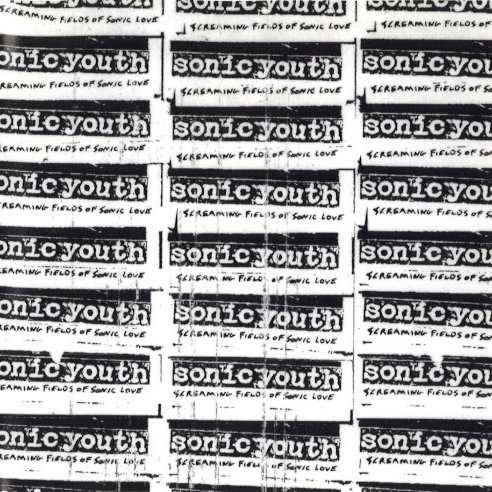 | Album: 12 of 28 Title: Screaming Fields of Sonic Love Released: 1994 Tracks: 17 Duration: 1:16:39 Scroll: Up Down Top Bottom 25% 50% 75% Allmusic Wikipedia AlbumCover | 1 Teen Age Riot (06:57) 2 Eric’s Trip (03:48) 3 Candle (04:59) 4 Into the Groove(y) (04:36) 5 G-Force (03:39) 6 Beauty Lies in the Eye (02:19) 7 Kotton Krown (05:08) 8 Shadow of a Doubt (03:33) 9 Expressway to Yr. Skull (07:19) 10 Star Power (04:49) 11 Death Valley ’69 (05:10) 12 Hallowe’en (05:09) 13 Flower (03:36) 14 Inhuman (04:02) 15 Making the Nature Scene (03:01) 16 Brother James (03:11) 17 I Dreamed I Dream (05:16) |
| Screaming Fields of Sonic Love : Allmusic album Review : Sonic Youth was never a singles band -- they may have released many 7" singles, but they rarely paid attention to conventional song structure, which meant their ideas couldnt always be distilled in the form of one three-minute song. Consequently, the idea of a compilation of highlights from their peak years at SST Records is a little odd, since each of their recordings -- from masterworks like Sister and Daydream Nation to one-offs like Ciccone Youths The Whitey Album and their EPs -- worked as a cohesive, individual entity. That said, the 17-track SST overview Screaming Fields of Sonic Love isnt nearly as bad as some die-hard fans might have suspected. Its true that it feels a little haphazard, but its ingenious sequencing -- running backward from 1988s Daydream Nation -- makes their noisier, atonal early recordings sound more accessible. And that means that the compilation is, in a weird way, a good choice for neophytes, since it does offer an easy introduction to the groups seminal 80s records. Longtime followers wont find anything unusual here, apart from edits of "Teen Age Riot" and "Candle," but it isnt designed for them -- its for the curious, and it will likely whet their appetites. | ||
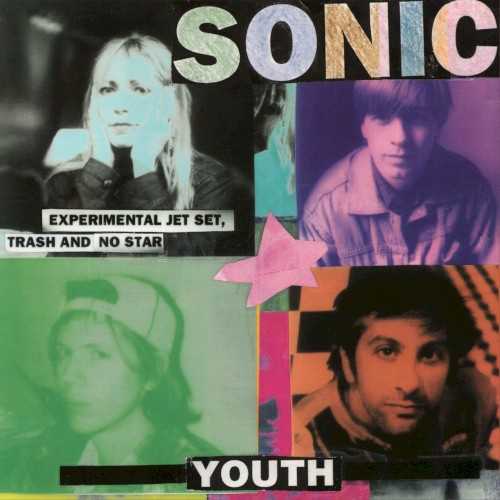 | Album: 13 of 28 Title: Experimental Jet Set, Trash and No Star Released: 1994-04-26 Tracks: 14 Duration: 50:16 Scroll: Up Down Top Bottom 25% 50% 75% Spotify Allmusic AlbumCover | 1 Winner’s Blues (02:07) 2 Bull in the Heather (03:04) 3 Starfield Road (02:15) 4 Skink (04:12) 5 Screaming Skull (02:39) 6 Self-Obsessed and Sexxee (04:30) 7 Bone (03:58) 8 Androgynous Mind (03:30) 9 Quest for the Cup (02:30) 10 Waist (02:49) 11 Doctor’s Orders (04:20) 12 Tokyo Eye (03:54) 13 In the Mind of the Bourgeois Reader (02:33) 14 Sweet Shine (07:50) |
| Experimental Jet Set, Trash and No Star : Allmusic album Review : Whereas Dirty and its predecessors were loud, distorted, and bordering on the fine line between pop and noise, Experimental Jet Set, Trash & No Star did away with the ear-bleeding guitar feedback so often attributed to the group. The group retained its quirky twist on pop/rock song structures, moving even closer to a consistent use of the verse-chorus-verse template. Of course, the disregard for mosh-friendly guitar riffs, lack of crowd-surfing intensity, and increasing traces of normalcy killed a large part of the groups momentous surge in popular acceptance, damning them once again to the status of often misunderstood artists. Popular opinion may have wanted more rock than what Sonic Youth wanted to deliver on this album, yet upon careful inspection, Experimental Jet Set, Trash & No Star still out-noises the majority of its peers. Butch Vigs clean production makes the album seem clean, when in actuality it is nearly as dirty as the groups preceding effort. Songs such as "Starfield Road" and the acoustic song "Winners Blues" emanate plenty of raw spontaneity, even with Vigs crystal clear production. Relative to Sonic Youths greater body of work, the album does seem rather sedate, though. The noises resonate subtly rather than mangle ones eardrum. In sum, this record must be considered the closest the group has ever gone to straight-ahead pop/rock. With all of the feedback, murky production, incoherent song structuring, and rambunctious charisma stripped away, what remains are odd lyrics and unique guitar nuance. In other words, Experimental Jet Set, Trash & No Star features the underlying foundation of the groups music standing naked, without any of their traditionally excessive static to heighten it. | ||
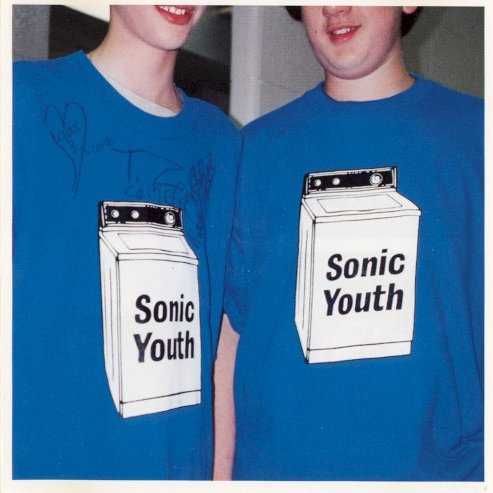 | Album: 14 of 28 Title: Washing Machine Released: 1995-09-26 Tracks: 11 Duration: 1:08:21 Scroll: Up Down Top Bottom 25% 50% 75% Spotify TrackSamples Allmusic AlbumCover | 1 Becuz (04:43) 2 Junkie’s Promise (04:02) 3 Saucer‐Like (04:25) 4 Washing Machine (09:33) 5 Unwind (06:02) 6 Little Trouble Girl (04:29) 7 No Queen Blues (04:35) 8 Panty Lies (04:15) 9 Becuz Coda (02:49) 10 Skip Tracer (03:48) 11 The Diamond Sea (19:35) |
| Washing Machine : Allmusic album Review : After the regressive, low-key Experimental Jet Set, Trash & No Star, Sonic Youth appeared to be floundering somewhat, but Washing Machine erased any notion that the band had run out of things to say. Easily their most adventurous, challenging, and best record since Daydream Nation, the album finds Sonic Youth returning to the fearless exploration of their SST records, but the group has found a way to work that into tighter song structures. Not only are the songs more immediate than most of the material on their earlier records, the sound here is warm and open, making Washing Machine their most mature and welcoming record to date. Its not a commercial record, nor is it a pop record, but Washing Machine encompasses everything that made Sonic Youth innovators, and shows that they can continue to grow, finding new paths inside their signature sound. | ||
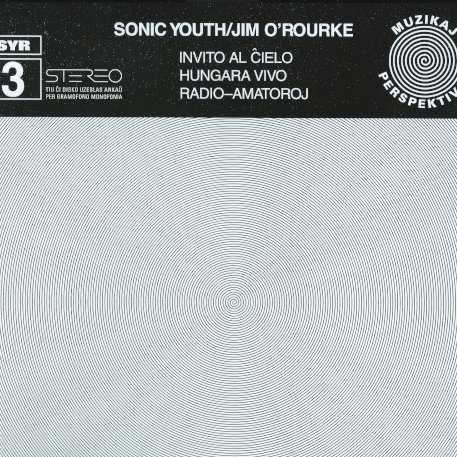 | Album: 15 of 28 Title: SYR 3: Invito al Ĉielo Released: 1998-03-02 Tracks: 3 Duration: 56:32 Scroll: Up Down Top Bottom 25% 50% 75% Spotify Wikipedia AlbumCover | 1 Invito al Ĉielo (20:54) 2 Hungara Vivo (06:16) 3 Radio-Amatoroj (29:21) |
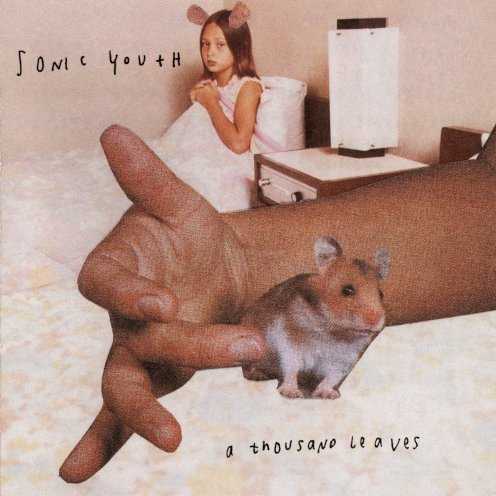 | Album: 16 of 28 Title: A Thousand Leaves Released: 1998-05-05 Tracks: 11 Duration: 1:14:04 Scroll: Up Down Top Bottom 25% 50% 75% Spotify Wikipedia Allmusic AlbumCover | 1 Contre le sexisme (03:55) 2 Sunday (04:52) 3 Female Mechanic Now on Duty (07:43) 4 Wildflower Soul (09:04) 5 Hoarfrost (05:01) 6 French Tickler (04:52) 7 Hits of Sunshine (For Allen Ginsberg) (11:05) 8 Karen Koltrane (09:20) 9 The Ineffable Me (05:21) 10 Snare, Girl (06:38) 11 Heather Angel (06:09) |
| A Thousand Leaves : Allmusic album Review : Truth be told, the grunge era never quite fit Sonic Youth. They may have been at the peak of their popularity, but they had traded their experimentalism for sheer, bracing noise. It may have sounded good, but ultimately Dirty didnt have the cerebral impact of Sister, largely because it was tied to an admittedly effective backbeat. Beginning with Washing Machine, Sonic Youth returned to more adventurous territory, and in 1997, they released a series of EPs that illustrated their bond with such post-rock groups as Tortoise and Gastr del Sol. Those EPs, as well as the epic Washing Machine closer, "The Diamond Sea," provide the foundation for A Thousand Leaves, the bands most challenging and satisfying record in years. The blasts of dissonance that characterized their SST masterworks have been replaced, by and large, by winding, intricate improvisations. Theres a surprising warmth to the subdued guitars of Thurston Moore, Lee Ranaldo, and Kim Gordon, which keeps the lengthy songs captivating. Both Moore and Ranaldo concentrate on quiet material, which almost makes Gordons noisy politicized rants sound a little out of place, but her best moments ("French Tickler," "Heather Angel") have unsettling, unpredictable twists and turns that greatly contribute to the success of A Thousand Leaves. It may be their most cerebral album in ages, but that only makes it all the more engaging. | ||
 | Album: 17 of 28 Title: SYR 4: Goodbye 20th Century Released: 1999-11-16 Tracks: 13 Duration: 1:43:53 Scroll: Up Down Top Bottom 25% 50% 75% Spotify Allmusic Wikipedia AlbumCover | 1 Edges (16:03) 2 Six (3rd take) (03:03) 3 Six for New Time (08:06) 4 +- (07:01) 5 Voice Piece for Soprano (00:17) 6 Pendulum Music (05:55) 1 Having Never Written a Note for Percussion (09:09) 2 Six (4th take) (02:10) 3 Burdocks (13:12) 4 Four⁶ (30:01) 5 Piano Piece #13 (Carpenter’s Piece) (03:58) 6 Pièce enfantine (01:28) 7 Treatise (03:25) |
| SYR 4: Goodbye 20th Century : Allmusic album Review : As a farewell to a century of musical innovation, Sonic Youth devote a double album to covering legendary avant-garde recordings such as John Cages "Six," James Tenneys "Having Never Written a Note for Percussion," and Christian Wolffs "Edges." As a further token of gratitude, Sonic Youth had other avant-garde musicians such as William Winant collaborate with them on these covers. The result is a minimal album of silence occasionally interrupted by strange dissonance that quietly reaps noisy havoc on your mind. The many collaborators make Goodbye 20th Century a curious listen -- certainly not your standard Sonic Youth album. Actually, its not too far removed from the other SYR EPs, especially in terms of production sound. But anyone looking for standard fare here is going to be greatly disappointed. These arent songs -- theyre compositions and theyre performed as such. Alt-rock this is not. | ||
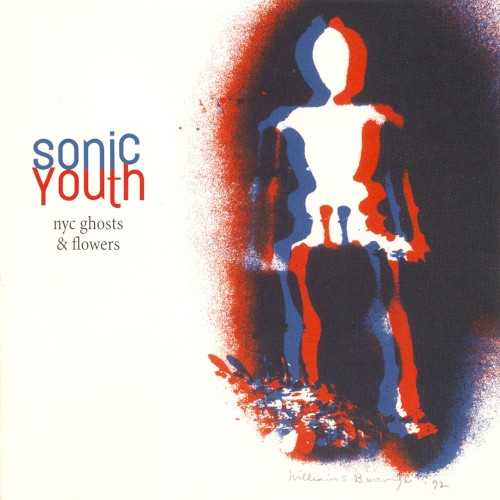 | Album: 18 of 28 Title: NYC Ghosts & Flowers Released: 2000-05-16 Tracks: 8 Duration: 42:21 Scroll: Up Down Top Bottom 25% 50% 75% Spotify Allmusic AlbumCover | 1 Free City Rhymes (07:32) 2 Renegade Princess (05:49) 3 Nevermind (What Was It Anyway) (05:37) 4 Small Flowers Crack Concrete (05:12) 5 Side2Side (03:34) 6 StreamXSonik Subway (02:51) 7 NYC Ghosts & Flowers (07:52) 8 Lightnin’ (03:51) |
| NYC Ghosts & Flowers : Allmusic album Review : Continuing their high-brow path towards avant-garde guitar music and away from their late 80s punk-influenced style of controlled cacophony, Sonic Youth have continued to make it difficult for fans to follow their evolving style of influential alternative rock. With the aid of renowned producer Jim ORourke, this iconic group has stripped away much of the murky sound that polluted its late 80s masterpieces such as Daydream Nation and Sister. This new style of clean production on NYC Ghosts & Flowers also differs from the groups early 90s sound partly attributed to Butch Vig on colorful albums such as Dirty and Experimental Jet Set, Trash & No Star, where Vig masterfully juxtaposed the groups knack for noise with his gift for salient production. Similar to Experimental Jet Set, Trash & No Star, Sonic Youth have again written a collection of shorter songs, focused primarily upon lyrics and song structuring rather than guitars. Thurston Moores songs dominate this record, sounding unlike anything he has ever written. These songs seem to evolve spontaneously, moving into and then out of Moores Ginsberg-like beatnik vocals. Songs such as "Free City Rhymes" and "Small Flowers Crack Concrete" sound like the music from SYR 1 and SYR 2 accompanied by subtly spoken poetry, focused more on enunciation than melody. More than ever, it seems as if Moore has abandoned his goofball charisma of the past for his new status as an ambitious poet looking to be respected as much for his words as his guitar. Kim Gordons contribution, "Nevermind (What Was It Anyway)," stands above all other songs on the album as the only song with a memorable yet kooky vocal melody: "Boys go to Jupiter to more stupider/ Girls go to Mars to become rock stars." Contributed by Lee Ranaldo, the title track of this album serves as the guitarists best lyrical piece to date and also as the albums grand finale, stretching to nearly ten minutes of slow building guitar intensity. In the end, this Sonic Youth album will appeal to those attracted to the groups mellow side -- a subtle side of the group more interested in collective contemplation than electrifying energy. Never before has the group sounded so consciously mature. For some fans, this album will sound refreshing, but for the many Sonic Youth fans still in love with the confrontational attitude of "Death Valley 69," the charged feel of "Teenage Riot," or the epic scope of "The Diamond Sea" this album may sound tired. | ||
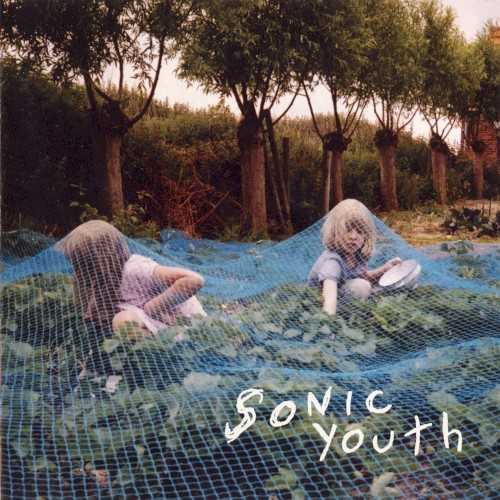 | Album: 19 of 28 Title: Murray Street Released: 2002-06-05 Tracks: 8 Duration: 56:13 Scroll: Up Down Top Bottom 25% 50% 75% Wikipedia Allmusic AlbumCover | 1 The Empty Page (04:20) 2 Disconnection Notice (06:24) 3 Rain on Tin (07:56) 4 Karen Revisited (11:10) 5 Radical Adults Lick Godhead Style (04:27) 6 Plastic Sun (02:14) 7 Sympathy for the Strawberry (12:06) 8 Street Sauce (07:32) |
| Murray Street : Allmusic album Review : Virtually every album Sonic Youth has released since the underrated Goo has been hailed as a return to form. However, Murray Street, their second collaboration with Jim ORourke (and their first with him as a full member of the group), not only recalls their past glories but explores new territory. Freed from the trendy agendas that marred A Thousand Leaves and NYC Ghosts & Flowers, the group revisits the complex, transcendent guitar epics that made them underground rock heroes in the first place. But Murray Street doesnt just rehash the sound of their late-80s heyday, either; for the most part, epics like the 60s-tinged "The Empty Page" and "Rain on Tin" -- which sounds a bit like a rural cousin to Televisions "Marquee Moon" -- are built on surprisingly clean, crisp guitar tones that only explode into occasional noise-storms. Indeed, the guitar work on the albums first three tracks is both economical and sensual, a feast of textures and counterpoints that never sounds overdone. Murray Streets wonderfully natural yet intricate sound is ORourkes most distinctive contribution to the group; while his work with Smog and Wilco pushed those groups to be more experimental and eclectic, with Sonic Youth he seems to give those tendencies focus and balance. Even the hypnotic drones at the end of "Karen Revisited," the albums noisy, oddly romantic centerpiece, have a unique precision and clarity. Murray Streets first four songs rank among the most consistent, and consistently exciting, work in Sonic Youths career, so much so that the albums shorter, more rock-oriented songs feel a bit anticlimactic. "Plastic Sun," a Kim Gordon-sung rant, feels particularly out of keeping with the rest of Murray Streets warm, expansive tone; "Radical Adults Lick Godhead Style" is a typical Sonic Youth rocker that suffers merely from not being as good as the first half of the album. Closing with the serenely sexy "Sympathy for the Strawberry," Murray Street reaffirms that at the groups best, Sonic Youth manages to sound fresh and timeless all at once. | ||
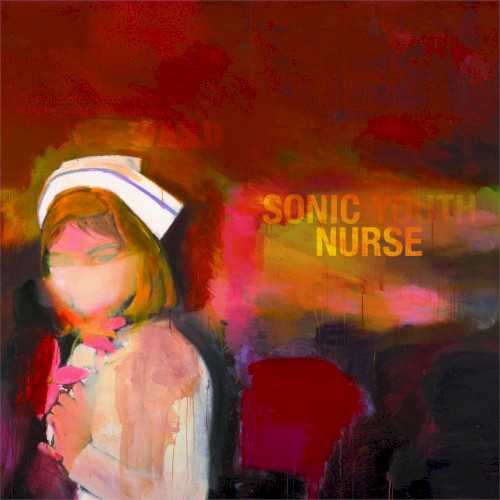 | Album: 20 of 28 Title: Sonic Nurse Released: 2004-06-07 Tracks: 12 Duration: 1:09:27 Scroll: Up Down Top Bottom 25% 50% 75% Spotify Wikipedia Allmusic AlbumCover | 1 Pattern Recognition (06:32) 2 Unmade Bed (03:53) 3 Dripping Dream (07:46) 4 Kim Gordon and the Arthur Doyle Hand Creme (04:51) 5 Stones (07:08) 6 Dude Ranch Nurse (05:44) 7 New Hampshire (05:12) 8 Paper Cup Exit (05:57) 9 I Love You Golden Blue (07:03) 10 Peace Attack (06:10) 11 Kim Chords (06:02) 12 Beautiful Plateau (03:07) |
| Sonic Nurse : Allmusic album Review : Picking up where Murray Streets languid experimentalism left off, Sonic Youths somewhat awkwardly named Sonic Nurse shows that the band still sounds revitalized, and may have even tapped into a more fruitful creative streak than they did on their previous album. Anyone who has stuck with Sonic Youth this long knows more or less what to expect from them, but the group still has the potential to surprise; one of Sonic Nurses biggest surprises is the return of Kim Gordon. She had a relatively limited presence on NYC Ghosts & Flowers and Murray Street, but shes back in a big way on this album, contributing four tracks; not coincidentally, Gordons songs are among the strongest on the album. "Pattern Recognition" gets Sonic Nurse off to a strong start and ranks among her best rock songs, falling somewhere between "Kool Thing" and "Bull in the Heather" in its icy-hot appeal. Her quieter songs have just as much impact: "Dude Ranch Nurse" boasts an oddly timeless guitar lick and lyrics ("Let me ride you till you fall/Lets pretend that theres nothing at all") that blur the line between alluring and nihilistic. "I Love You Golden Blue" is another standout, a beautiful but bleak ballad with ghostly vocals that recall Nico at her most fragile. Of course, the rest of the band finds moments to shine: Thurston Moores "Dripping Dream" begins as absurdist, angular rock (although he still has the ability to make phrases like "Weve been searching for the cream dream wax" sound like the coolest thing ever) and stretches out into a beautiful epic, with the interplay of feedback and guitar lines giving it a comet-tail majesty. "Paper Cup Exit," the requisite Lee Ranaldo track, has a sharper-edged mix of noise and melody than most of Sonic Nurse. Another of the albums surprises is how much of its inspiration seems to come from the bands late-80s/early-90s material. Its not just that the band slams George W. Bush on the mellow protest song "Peace Attack," just as Dirtys "Youth Against Fascism" railed against the first President Bush, or that they peer into the void of pop culture on "Kim Gordon and the Arthur Doyle Hand Cream" as they did on Goos Karen Carpenter tribute, "Tunic." On songs like "New Hampshire" -- which could pass for a lost track from Daydream Nation -- Sonic Youth actually sound younger and more enthusiastic than they have in a few albums. All told, this album is probably the bands best balance of pop melodies and avant-leaning structures since Washing Machine; even if it doesnt rank among their most ambitious work, Sonic Nurse sounds like the kind of album Sonic Youth should be making at this point in their career. | ||
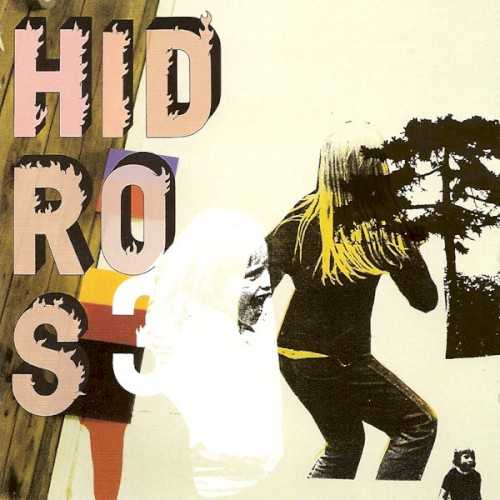 | Album: 21 of 28 Title: Hidros 3 Released: 2004-09-21 Tracks: 9 Duration: 1:06:32 Scroll: Up Down Top Bottom 25% 50% 75% Spotify Allmusic AlbumCover | 1 Part 1 intro (02:40) 2 Part 2 voice (17:39) 3 Part 3 contrabass sax (06:01) 4 Part 4 voice (02:00) 5 Part 5 processed voice (11:58) 6 Part 6 voice (01:58) 7 Part 7 contrabass sax (06:15) 8 Part 8 processed voice (09:52) 9 Part 9 voice (08:05) |
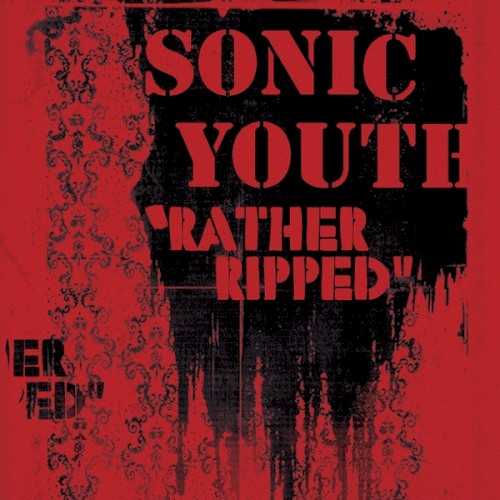 | Album: 22 of 28 Title: Rather Ripped Released: 2006-06-05 Tracks: 13 Duration: 56:29 Scroll: Up Down Top Bottom 25% 50% 75% Spotify TrackSamples Allmusic AlbumCover | 1 Reena (03:47) 2 Incinerate (04:55) 3 Do You Believe in Rapture? (03:11) 4 Sleepinʼ Around (03:42) 5 What a Waste (03:33) 6 Jams Run Free (03:52) 7 Rats (04:24) 8 Turquoise Boy (06:14) 9 Lights Out (03:32) 10 The Neutral (04:09) 11 Pink Steam (06:57) 12 Or (03:29) 13 Helen Lundeberg (04:38) |
| Rather Ripped : Allmusic album Review : Considering that Sonic Youth lost Jim ORourke and found the custom-tweaked, irreplaceable guitars that were stolen in 1999 before heading into the studio to make Rather Ripped, it seemed that the album could be a big departure from what theyd been doing on Murray Street and Sonic Nurse -- possibly a return to the kind of music they could only make with those instruments, or perhaps an entirely different approach that reflected their revamped, old-is-new-again lineup. Rather Ripped ends up being of a piece with their previous two albums, and often plays like a stripped-down, slightly less-inspired Sonic Nurse. Once again, Kim Gordon contributes some of the best tracks here; "Reena" and "Jams Run Free" are equal parts dreamy and driving, while "The Neutral" is a sweet, low-key love song. Thurston Moore contributes a gently but powerfully political track à la Sonic Nurses "Peace Attack" with "Do You Believe in Rapture?," a reflection on peace and apocalypse thats mostly serene, even if the guitar harmonics throughout the song add shivers of doubt and tension. "Rats" is a standard-issue Lee Ranaldo song, freewheeling and poetic (and with lines like "Let me place you in my past/With other precious toys," it has the sharpest lyrics on Rather Ripped), even if its not quite as amazing as the previous albums "New Hampshire." Rather Rippeds rock songs are solid, but not amazing -- the interplay of Moores and Ranaldos guitars and Steve Shelleys drumming are the best things about "Sleepin Around" and "What a Waste." Actually, the more atmospheric songs end up being some of the most compelling. "Lights Out" reeks of whispery, late-night cool, and the closing track, "Or," is one of the sparest and most oddly unsettling songs Sonic Youth has done in a while (not to mention a reminder that quiet doesnt always mean peaceful in this bands world). Rather Ripped is also surprisingly lean, with the songs on its first half feeling so tightly structured that they seem like radio edits. Only "Turquoise Boy" and "Pink Steam" really open up and deliver Sonic Youths famously sprawling, jam-based sound. If Rather Ripped is a tiny bit disappointing, its only because the bands playing outpaces their songwriting ever so slightly. Its a solidly good album, and if taken as part of a trio of albums with Sonic Nurse and Murray Street, it shows that Sonic Youth is still in a comfortable yet creative groove, not a rut. | ||
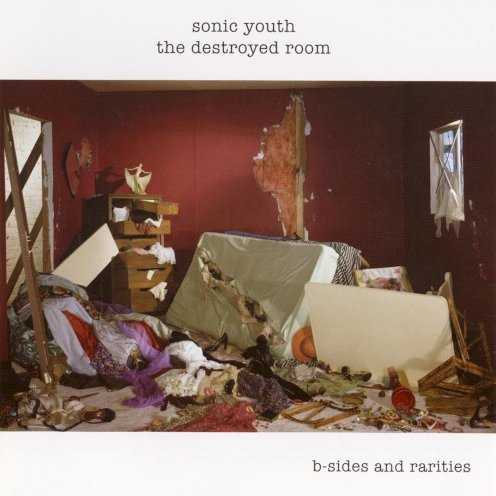 | Album: 23 of 28 Title: The Destroyed Room: B-Sides and Rarities Released: 2006-12-11 Tracks: 13 Duration: 1:24:05 Scroll: Up Down Top Bottom 25% 50% 75% Allmusic AlbumCover | 1 Fire Engine Dream (10:22) 2 Fauxhemians (04:04) 3 Is It My Body? (02:49) 4 Doctors Orders (T-Vox version) (04:20) 5 Razor Blade (01:08) 6 Blink (05:27) 7 Campfire (02:19) 8 Loop Cat (05:39) 1 Kim Chords (06:02) 2 Beautiful Plateau (03:07) 3 Three-Part Sectional Love Seat (08:16) 4 Queen Anne Chair (04:37) 5 The Diamond Sea (25:50) |
| The Destroyed Room: B-Sides and Rarities : Allmusic album Review : Devoted to the more open-ended rarities that have gathered in Sonic Youths discography in the decade spanning from Experimental Jet Set, Trash & No Star to Sonic Nurse, The Destroyed Room serves as a reminder that even the bands sketches and non-album tracks remain fascinating. Pieces like the Murray Street outtake "Fauhemians" and "Campfire," which originally appeared in the 1999 collection At Home with the Groovebox and sounds like static kisses, are great examples of Sonic Youths ability to make dissonant, weird, and otherwise unexpected sounds feel soothing (something theyve done especially well in recent years). Likewise, "Fire Engine Dream," the ten-minute Sonic Nurse-era jam that kicks off The Destroyed Room, is pretty subtle despite its hypnotic fuzz; along with the shimmering sound collage "Loop Cat," it shows that the bands seemingly far-flung experiments are balanced with structure and restraint. Given that many of the tracks here ended up tucked away as bonus tracks on Japanese editions of albums, or on the cutting-room floor, its understandable that an unfinished feel pervades The Destroyed Room. This incompeleteness is by no means a bad thing, though, especially on the twangy, off-the-cuff Experimental Jet Set snippet "Razor Blade" and the beautiful "Kims Chords," an instrumental full of changing moods and Sonic Youths distinctive ebb and flow. There are also a few fleshed-out but hard to find songs here, chief among them "Blink," the bands contribution to the soundtrack to Pola X, Leos Caraxs 1999 experimental film noir, and the (very) full, 25-minute long version of "The Diamond Sea," which emphasizes the avant jam band feel theyve cultivated in later years. Just as this collections name and artwork turn the rock cliché of trashing a room into a work of art, The Destroyed Room is a creative -- and quintessentially Sonic Youth -- approach to the rarities and B-sides comp. | ||
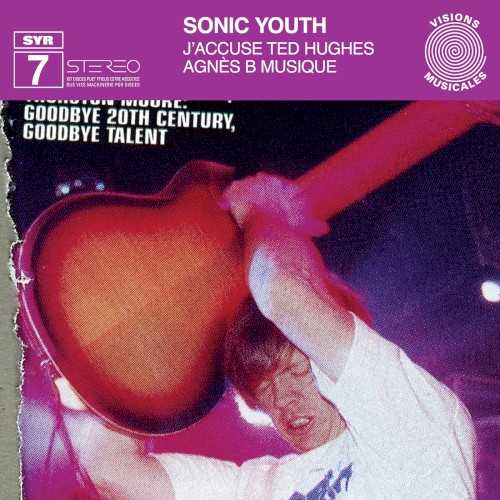 | Album: 24 of 28 Title: SYR 7: J’accuse Ted Hughes Released: 2008-04-22 Tracks: 2 Duration: 41:08 Scroll: Up Down Top Bottom 25% 50% 75% Spotify Wikipedia Allmusic AlbumCover | 1 J’accuse Ted Hughes (22:53) 2 Agnès B Musique (18:15) |
| SYR 7: J’accuse Ted Hughes : Allmusic album Review : Sonic Youth continued to shadow overtly populist releases such as the 2006 comeback RATHER RIPPED with deeply experimental noisescapes more in line with their first releases, CONFUSION IS SEX and SONIC DEATH. J’ACCUSE TED HUGHES, the seventh in a series of vinyl-only releases on Sonic Youth Records, contains two epic drone tracks. Side A contains the title track, a previously unreleased live performance from the All Tomorrow’s Parties Festival in April 2001, the only time the band ever performed the song. Side B features “Agnes B Musique,” an 18-minute monster intended for use by Agnes B, the clothing designer. Jim O’Rourke appears as a member of Sonic Youth on “Agnes B Musique” and also mixed the track. | ||
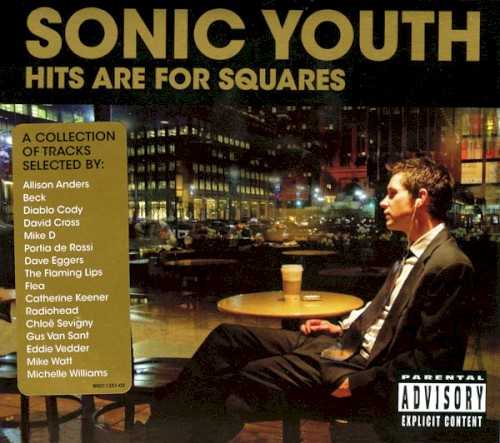 | Album: 25 of 28 Title: Hits Are for Squares Released: 2008-06-10 Tracks: 16 Duration: 1:16:08 Scroll: Up Down Top Bottom 25% 50% 75% Wikipedia Allmusic AlbumCover | 1 Bull in the Heather (03:06) 2 100% (02:30) 3 Sugar Kane (05:57) 4 Kool Thing (04:06) 5 Disappearer (05:08) 6 Superstar (04:08) 7 Stones (07:08) 8 Tuff Gnarl (03:17) 9 Teen Age Riot (06:57) 10 Shadow of a Doubt (03:33) 11 Rain on Tin (07:56) 12 Tom Violence (03:05) 13 Mary‐Christ (03:11) 14 World Looks Red (02:41) 15 Expressway to Yr Skull (07:08) 16 Slow Revolution (06:14) |
| Hits Are for Squares : Allmusic album Review : Leave it to Sonic Youth to put a twist on the typical greatest-hits album. Originally released in 2008, Hits Are for Squares features tracks selected by writers, artists, actors, and musicians. With a roster of curators that includes Alison Anders, Radiohead, Chloë Sevigny, and the Flaming Lips, this comp could have become a contest to pick the most obscure song (if it were, then Sevigny would win with her selection, “World Looks Red” from 1983’s Confusion Is Sex). For the most part, however, the album sticks with well-known tracks, with a smattering of songs that would be considered hits: “Kool Thing,” “Teenage Riot,” “Bull in the Heather,” and “Sugar Kane” all appear without feeling too obligatory. Indeed, the bulk of Hits Are for Squares comes from Sonic Youth’s alternative nation heyday in the early to mid-‘90s, with special attention paid to Dirty and Goo (two of that album’s cuts, “Disappearer” and “Mary-Christ,” were chosen by Portia de Rossi and David Cross, respectively). Yet just as many songs come from 1987’s sometimes overlooked EVOL, including the haunting “Shadow of a Doubt” and the album’s closing epic, “Expressway to Yr Skull.” Speculating why certain songs were chosen by certain people is entertaining in its own right; Diablo Codys choice of the subversive-yet-heartfelt Carpenters cover “Superstar” seems to make perfect sense, given the nimble way she balances kitsch, irony, and genuine emotion in her own work. Likewise, Eddie Vedders choice of “Teenage Riot,” one of the most earnest moments in Sonic Youths songbook, feels spot-on. The band’s body of work is broad and deep enough that most fans probably have custom mixes of their own favorite songs, so for them, this collection is more pleasant than essential, though the inclusion of an exclusive track, “Slow Revolution,” may push diehards to get the album. Still, like the greatest-hits collections it tries to avoid being like, Hits Are for Squares works surprisingly well as an introduction to Sonic Youths sound and approach. | ||
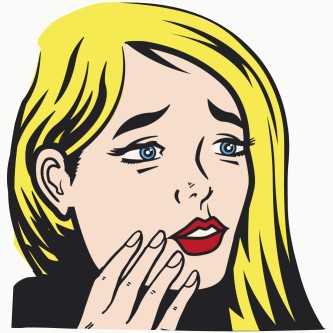 | Album: 26 of 28 Title: 14 Tracks: The Other Side of Sonic Youth Released: 2009-03-11 Tracks: 14 Duration: 1:35:31 Scroll: Up Down Top Bottom 25% 50% 75% AlbumCover | 1 Having Never (09:09) 2 Tremens (03:22) 3 Off Work (04:14) 4 Hungara (06:16) 5 Silver Panties (04:27) 6 Take It to the Hit (04:27) 7 Chinese Jam (01:11) 8 Agnes B Musique (18:38) 9 Petite Bone (02:30) 10 Slaapkamers (17:44) 11 052402 Echo 3 and 2 (05:15) 12 Piece Enfantine (01:28) 13 Heady Jam 2 (14:13) 14 Billboard (02:37) |
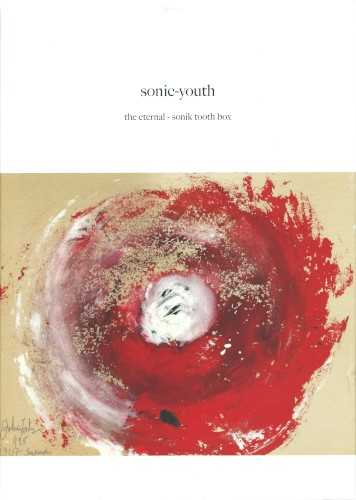 | Album: 27 of 28 Title: The Eternal Released: 2009-06-03 Tracks: 25 Duration: 1:53:07 Scroll: Up Down Top Bottom 25% 50% 75% Spotify TrackSamples Wikipedia Allmusic AlbumCover | 1 Sacred Trickster (02:11) 2 Anti-Orgasm (06:07) 3 Leaky Lifeboat (For Gregory Corso) (03:32) 4 Antenna (06:13) 5 What We Know (03:54) 6 Calming the Snake (03:36) 7 Poison Arrow (03:42) 8 Malibu Gas Station (05:39) 9 Thunderclap for Bobby Pyn (02:38) 10 No Way (03:52) 11 Walkin Blue (05:21) 12 Massage the History (09:51) 13 Pay No Mind (03:17) 14 No Garage (03:53) 1 She Is Not Alone (06:10) 2 The Sprawl (07:46) 3 World Looks Red (02:57) 4 Jams Run Free (03:43) 5 Hey Joni (04:19) 6 The Wonder (04:08) 7 Hyperstation (05:50) 8 Bull in the Heather (02:59) 9 100% (02:57) 10 Making the Nature Scene (03:14) 11 Silver Rocket (05:18) |
| The Eternal : Allmusic album Review : If anyone thought Sonic Youth were getting a little too comfortable, The Eternal proved they werent afraid of change, even as they closed in on 30 years of making music together. The Eternal is Sonic Youths first album for legendary indie label Matador Records after a nearly 20-year stint with Geffen Records, which dovetails nicely with the fact that this is also the bands first album with former Pavement bassist (and Matador alum) Mark Ibold. Sonic Youth even changed their usual songwriting approach, writing and recording tracks in quick batches instead of planning an entire song cycle at once. Dust wasnt allowed to settle on these songs, nor could it -- the most striking thing about The Eternal is how hard it rocks. The contemplative haze that drifted over Murray Street, Sonic Nurse, and to a lesser extent Rather Ripped is blasted away by opening track "Sacred Trickster"s lunging, massive guitars and Kim Gordons demand to be pressed up against an amp. The rest of the band sounds revitalized, too: Lee Ranaldos excellent "What We Know" is a furious yet complex rocker, and Thurston Moore sounds like the leader of the gang on "Thunderclap for Bobby Pyn," which name-drops the Heavens Gate cult and the alias of Germs singer Darby Crash between its "whoa-oh" and "yeah yeah"-fueled choruses. This is the heaviest Sonic Youth have been since Sister, and its fitting that their return to the indie world touches on their SST days. Thats not the only era they revisit, however. "Poison Arrow"s skronky grind evokes Dirtys sexier moments; "Antenna"s radio love turns Murray Streets sun-streaked drones into epic pop; and "Calming the Snake"s tumbling, atonal riffing suggests summery menace as much as it does Sonic Youths no wave roots. While theres a little bit of almost everything that has made Sonic Youth great over the years, the band hasnt put these elements together in precisely this way before. Considering how expansive their last few albums for Geffen were, The Eternals relatively concise songs also set it apart, but when Sonic Youth do stretch out, its with purpose. "Anti-Orgasm" begins as a duet/duel between Gordon and Moore, who trade challenges and come-ons over free-falling guitars that become a rolling, slow-motion excursion; the tracks instrumental interplay is more violent, and more sensual, than its words. "Massage the History" is even more vast, encompassing fragile acoustic strumming, distortion storms, and dead calm over its nearly ten-minute expanse. While The Eternal doesnt flow quite as effortlessly as some Sonic Youth albums, its perfectly balanced, its raw moments tempered by the subtle "Walkin Blue" and "Malibu Gas Station," which creeps so imperceptibly toward its raging guitars that theyre almost unnoticed until youre caught in their undercurrent. Sonic Youths freedom to follow their bliss is what holds The Eternal together; just as paradoxically, the changes they make on this album not only bring excitement to their music, they reaffirm just how consistently good the band has been -- and continues to be -- over the years. | ||
 | Album: 28 of 28 Title: Spinhead Sessions • 1986 Released: 2016-06-17 Tracks: 7 Duration: 40:18 Scroll: Up Down Top Bottom 25% 50% 75% AlbumCover | 1 Ambient Guitar & Dreamy Theme (16:39) 2 Theme with Noise (04:16) 3 High Mesa (08:36) 4 Unknown Theme (02:41) 5 Wolf (01:37) 6 Scalping (03:57) 7 Theme 1 (take 4) (02:32) |